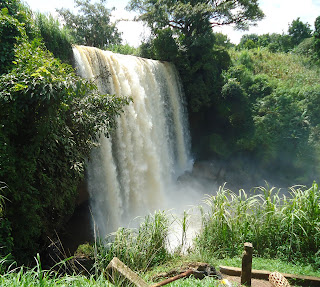Restore Gloria's Vision
--Note: This article, and the appeal to help Gloria, can also be found on the site YouCaring: https://www.youcaring.com/glorialakeraciro-831841?utm_source=frlive&utm_content=cf_cp_01
Every day, Gloria Laker Aciro’s world gets a little blurrier.
This would be awful for anyone, but is especially tragic in Gloria’s case, since, in her middle 40's, she has so much left to accomplish as East Africa’s foremost peace journalist.
Gloria Laker Aciro was the first woman reporter to cover the LRA war in the field in Northern Uganda in the 1990’s. Gloria was literally Ugandan journalism’s Rosa Parks, not only breaking down barriers with her mere presence, but showing that a woman can be every bit as effective in covering conflicts (or anything else) as a man.
Her bravery, professionalism, and courage as a war correspondent are legendary in Northern Uganda. She survived abduction, sexual assault, landmines, and ambushes which were all common during the LRA war. It is no exaggeration that she risked her life for her profession, and for the people of Northern Uganda who desperately needed accurate information about the war—information that could make the difference between safety or being kidnapped or killed by LRA forces.
Gloria’s groundbreaking work during the Ugandan civil war is, in fact, the subject of a segment produced on BBC’s Outlook Inspirations program. (
http://www.bbc.co.uk/programmes/p03wbz3x )
After the war, Gloria launched the Peace Journalism Foundation of East Africa, which “advocates for peaceful media interventions as a way of preventing conflict and encouraging sustainable development in the East African region.”
I have had the privilege of working alongside Gloria since 2009 on dozens of peace journalism seminars and projects in Uganda, Kenya, and South Sudan. She was even one of our featured speakers at a Peace Journalism Summit in Istanbul, Turkey in 2013. Gloria is a fountain of inspiration and information about the importance of reporting that doesn’t exacerbate conflicts, fuel ethnic strife, and inflame violence.
Sadly, all that work may be coming to an end, since, because of cataracts, Gloria’s eyesight is getting blurrier with each passing day.
I had the good fortune to be born in the U.S., where removing cataracts is almost as routine as a trip to the grocery store. It’s unimaginable that anyone in the U.S. or other western countries could go blind from cataracts.
For most Ugandans like Gloria, paying for cataract surgery is far out of reach. The average annual salary in Uganda is $7038. The cost of the cataract surgery that Gloria needs in both eyes totals $8000.
Imagine having to come up with more than your entire annual salary in cash to save your eyesight.
Here’s the good news--it’s not too late to save Gloria’s eyesight, although time of the essence.
The Parkville, Missouri Rotary Club is collecting funds to finance Gloria’s surgery in both eyes. When the goal is reached, they will directly pay the doctor and hospital in Uganda. It's easy--just go to the YouCaring fundraising site, and click donate. When you get to the PayPal page, it will say "Parkville Rotary Charities." Then you'll know you're in the right place.
https://www.youcaring.com/glorialakeraciro-831841?utm_source=frlive&utm_content=cf_cp_01
You can also help by spreading the word to others who might be inclined to contribute.
Your generosity will restore Gloria’s eyesight, and allow her to continue her vital peacebuilding work. Moreover, it will allow Gloria to continue to function in her most important role of all: as doting mother to two beautiful, energetic girls, Cindy (15), and Stephanie Isabella (8).
Thank you for your generosity.
Steven Youngblood, friend and colleague to Gloria
Honorary member, Parkville Rotary Club
Professor and Director, Center for Global Peace Journalism, Park University


































